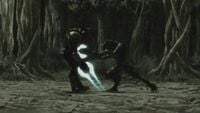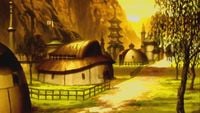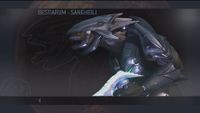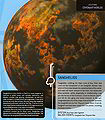Sanghelios
From Halopedia, the Halo wiki
Sanghelios, designated CE-80-9012 d by the Forerunners,[1] is the homeworld of the Sangheili species. Sanghelios is the fourth planet in the Urs system, a triple star system containing Urs, Fied, and Joori. The planet has two moons called Qikost and Suban.[2] As a spacefaring species, the Sangheili have colonized multiple worlds in addition to Sanghelios as they expanded the reach of their own civilization and later the empire of the Covenant.[3]
History
Sanghelios had at one point been visited by or had been in contact with the Forerunners, as Forerunner artifacts were left on Sanghelios. During the Forerunner-Flood war and the Lifeworkers' Conservation Measure, the Librarian visited the planet to retrieve specimens of the Sangheili for preservation. After the firing of the Halo Array, the Sangheili preserved aboard the Ark were returned to their homeworld to begin rebuilding their culture.[4]
After being returned to their homeworld, the Sangheili discovered artifacts left by the Forerunners on their planet. The Sangheili revered the objects these "gods" had left, and considered tampering with them a heresy beyond any other. Over time, the Sangheili on Sanghelios developed their technology and became a space-faring race, subsequently colonizing several worlds.
In 938 BCE they encountered the Reformist San 'Shyuum a race who also worshipped the Forerunners as gods, but had utilized Forerunner technology for their own needs, believing the technology had been left behind by the gods as gifts for their children.[5] This sparked a war between the two races over how to treat the relics. Part of the war was fought on Sanghelios, with the San 'Shyuum's Keyship, the Forerunner Dreadnought, devastating military forces planetside. In time, the Sangheili learned of the San 'Shyuum's belief in the Great Journey, where the Forerunners used the Halo Array to ascend to a god-like state, and wished to repeat this process on themselves. Coupled with this belief and the fact that the cause of war was obsolete, the Sangheili agreed to unite with the San 'Shyuum into an alliance to avoid mutual extinction. In 852 BCE, the two races signed a treaty known as the Writ of Union to form the early Covenant.[6]
During the Human-Covenant War, many Sangheili warriors from Sanghelios joined the Covenant's campaign against humanity.[7] Many Sangheili manufacturers on and around the planet provided weapons and vehicles for the Covenant. After the Human-Covenant War, the Arbiter Thel 'Vadam returned to Sanghelios.[8] He planned to visit each state to make his case for permanent peace with the humans they had battled for so many years.[9] These reforms did not meet with universal approval. By January 2553, there was great dissent among disparate Sangheili factions, especially from the more devout believers in the Forerunners' divinity. Some, such as Avu Med 'Telcam and his Servants of the Abiding Truth, saw the Arbiter as a traitorous leader that has betrayed their faith and sought to finish their war with humanity.[10]
In March 2553, much of the northern hemisphere of Sanghelios became engulfed in a civil war between the Servants of the Abiding Truth and the forces loyal to Arbiter Thel Vadam.[11] By 2558, the Arbiter's followers were firmly in control of the planet. Rear Admiral Horatio Temkin served as the UNSC's Ambassador to Sanghelios at this time.[12] Recently, a human-Sangheili "librarian" team began to research archived Covenant records on the planet.[1]
Topography
Sanghelios has a gravity of 1.375 Gs, and an average surface temperature of -5°C to 96°C (23°F to 204.8°F). The Forerunners' Bestiarum indicates that Sanghelios is similar to Earth in shape and proportion, though the land masses and multiple continents are more scattered in relation to bodies of water. There is a large variation of vegetation and temperature on the planet. Sanghelios' sky varies in hue from a bright yellow to a blood red, due to large amounts of suspended particles in the upper atmosphere.[7] Like Earth, its atmosphere consists of oxygen, argon and nitrogen, but also has a reddish hue to it, perhaps indicating large amounts of hematite or molten rock. The saline oceans are tinted red.[13]
Many Forerunner artifacts and structures exist on the planet, which are the topic of worship, as well as the cause of historical wars between the Sangheili and the San 'Shyuum before the formation of the Covenant.[2] Outside the cities, Sanghelios' landscape has stayed mostly unchanged for several millennia; the terrain is mostly agricultural, and the keeps mostly follow ancient, pre-Covenant architectural styles.[14]
Locations
Ground locations
Orbital locations
Ecology
Sanghelios is home to numerous animal and planet species, widely different from those on Earth. Some of these animals are domesticated, like the colo which is farmed across Sanghelios for its meat.[15] Doarmir are furry animals that are hunted for their fur, which is used for clothing.[16] Helioskrills are large, predatory creatures that live in the mountains of Sanghelios, respected by the Sangheili for their hunting positions.[17] Intestinal parasites — nishum — are common pests on the planet.[18] The waters on Sanghelios are home to large, predatory aquatic cephalopods that prey on unsuspecting creatures that wander into their territory. The skies of Sanghelios are often filled with a variety of avian-like animals.[19] There are also small, rat-like creatures that live on the planet, hunted by adolescent Sangheili.[20]
The planet is also home to numerous types and varieties of vegetation. Irukan is commonly grown on the planet, usually by Kig-Yar.[21] Kafel is a plant with a durable, wooden trunk that is often used in Sangheili construction.[22]
Government and society
Being a homeworld, the planet is inhabited by approximately 8.132 billion Sangheili.[2] As with the nature of Sangheili governments in general, Sanghelios has no global capital and most of the planet's inhabitants live in states led by and named after a particular Sangheili family.[23][24] A given state is governed by a single clan residence and assembly house known as a keep, headed by a kaidon selected by a council of elders. There are usually a number of "client keeps" belonging to different clans under the leading keep's rule,[25] though a state's elders will assume the kaidon's clan name as a title signifying their position, regardless of the name of their own family keep.[14]
These states vary greatly in size and wealth, ranging from small, rural ones like Mdama to urban city-states like Ontom, which mix old Sangheili architecture and modern, Covenant-era structures.[26] Unggoy and Jiralhanae laborers also live on the planet as workers for the Sangheili, and Kig-Yar merchants often visit to trade with the planet's inhabitants.[27]
Notable residents
- Fal 'Chavamee
- Haka
- Han 'Chavamee
- Thel 'Vadam
- Usze ‘Taham
- Toha ‘Sumai
- Rtas 'Vadum
- Avu Med 'Telcam
- Jul ‘Mdama
- Levu 'Mdama
- Forze 'Mdama
- Raia 'Mdama
Trivia
- The name "Sanghelios" comes from the Latin sanguis and the Greek helios meaning "Blood-Sun". It is implied that this may refer to the emphasis on blood in the culture of the warrior Sangheili that live there.
- The Doctor Who episode "Planet of the Dead" features a planet called San Helios, which is also part of a triple star system.[28]
- In Halo: The Cole Protocol, Sanghelios is mistakenly referred to as "Sanghelion" in chapter headings.[29]
Gallery
A duel between Fal 'Chavamee and a rivaling Sangheili in forest terrain on Sanghelios.
The future Shipmaster of the Fleet of Righteous Vigilance, duelling with a fellow clanmate on Sanghelios.
An unknown aquatic creature which inhabits Sanghelios. It is currently preying upon a Sangheili submerged within water.
Sanghelios as seen in the Bestiarum.
Sanghelios from the Halo Encyclopedia.
List of appearances
- Halo 3 Template:First mentioned
- Bestiarum (First appearance)
- Halo: The Cole Protocol
- Halo Legends
- Halo: Evolutions - Essential Tales of the Halo Universe
- The Return (Motion comic only)
- Halo: Blood Line
- Halo: Glasslands
- Halo: The Thursday War
- Halo: Mortal Dictata (Mentioned only)
- Halo: Broken Circle
Sources
- ^ a b Waypoint: Catalog Interaction page 14
- ^ a b c Halo 3, Bestiarum
- ^ Eleventh Hour reports - Report 2
- ^ Halo Legends, Origins
- ^ Halo: Contact Harvest, page 147
- ^ Halo Encyclopedia, page 30
- ^ a b Halo Encyclopedia, page 311
- ^ Halo 3, campaign level, Halo
- ^ Halo: Glasslands, page 130
- ^ Halo: Glasslands, pages 58-61
- ^ Halo: The Thursday War
- ^ Halo: Escalation, issue 5
- ^ Halo: Glasslands, page 354
- ^ a b Halo: Glasslands, page 57
- ^ Halo: The Thursday War, page 205
- ^ Halo: The Cole Protocol, page 159
- ^ Halo: The Cole Protocol, page 188
- ^ Halo: The Thursday War, page 79
- ^ Halo: The Thursday War, page 261
- ^ Halo: The Flood, page 5
- ^ Halo: The Thursday War, page 62
- ^ Halo: The Cole Protocol, page 89
- ^ Halo: The Cole Protocol, page 93
- ^ Halo: Glasslands, page 58
- ^ Halo: Glasslands, page 94
- ^ Halo: Glasslands, page 135-136
- ^ Halo: Glasslands, page 134
- ^ San Helios at TARDIS Index File, Doctor Who wiki
- ^ Halo: The Cole Protocol, pages 88, 349









